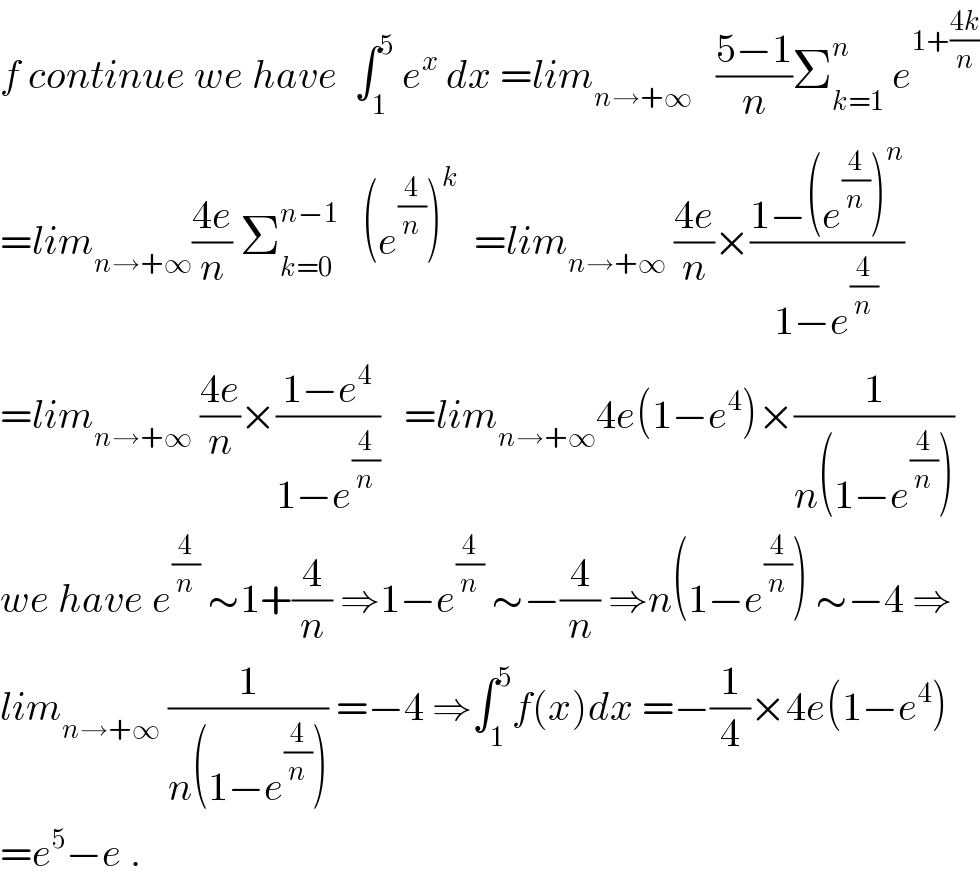
Question Number 93941 by Ar Brandon last updated on 16/May/20
![Show that the function f(x)=e^(x ) is of Reimann within x∈[1;5] hence calculate ∫_1 ^5 e^x dx](Q93941.png)
$$\mathrm{Show}\:\mathrm{that}\:\mathrm{the}\:\mathrm{function}\:\mathrm{f}\left(\mathrm{x}\right)=\mathrm{e}^{\mathrm{x}\:} \:\mathrm{is}\:\mathrm{of}\:\mathrm{Reimann}\:\mathrm{within} \\ $$$$\mathrm{x}\in\left[\mathrm{1};\mathrm{5}\right]\:\mathrm{hence}\:\mathrm{calculate}\:\int_{\mathrm{1}} ^{\mathrm{5}} \mathrm{e}^{\mathrm{x}} \mathrm{dx} \\ $$
Commented by mathmax by abdo last updated on 16/May/20

$${f}\:{continue}\:{we}\:{have}\:\:\int_{\mathrm{1}} ^{\mathrm{5}} \:{e}^{{x}} \:{dx}\:={lim}_{{n}\rightarrow+\infty} \:\:\:\frac{\mathrm{5}−\mathrm{1}}{{n}}\sum_{{k}=\mathrm{1}} ^{{n}} \:{e}^{\mathrm{1}+\frac{\mathrm{4}{k}}{{n}}} \\ $$$$={lim}_{{n}\rightarrow+\infty} \frac{\mathrm{4}{e}}{{n}}\:\sum_{{k}=\mathrm{0}} ^{{n}−\mathrm{1}} \:\:\:\left({e}^{\frac{\mathrm{4}}{{n}}} \right)^{{k}} \:\:={lim}_{{n}\rightarrow+\infty} \:\frac{\mathrm{4}{e}}{{n}}×\frac{\mathrm{1}−\left({e}^{\frac{\mathrm{4}}{{n}}} \right)^{{n}} }{\mathrm{1}−{e}^{\frac{\mathrm{4}}{{n}}} } \\ $$$$={lim}_{{n}\rightarrow+\infty} \:\frac{\mathrm{4}{e}}{{n}}×\frac{\mathrm{1}−{e}^{\mathrm{4}} }{\mathrm{1}−{e}^{\frac{\mathrm{4}}{{n}}} }\:\:\:={lim}_{{n}\rightarrow+\infty} \mathrm{4}{e}\left(\mathrm{1}−{e}^{\mathrm{4}} \right)×\frac{\mathrm{1}}{{n}\left(\mathrm{1}−{e}^{\frac{\mathrm{4}}{{n}}} \right)} \\ $$$${we}\:{have}\:{e}^{\frac{\mathrm{4}}{{n}}} \:\sim\mathrm{1}+\frac{\mathrm{4}}{{n}}\:\Rightarrow\mathrm{1}−{e}^{\frac{\mathrm{4}}{{n}}} \:\sim−\frac{\mathrm{4}}{{n}}\:\Rightarrow{n}\left(\mathrm{1}−{e}^{\frac{\mathrm{4}}{{n}}} \right)\:\sim−\mathrm{4}\:\Rightarrow \\ $$$${lim}_{{n}\rightarrow+\infty} \:\frac{\mathrm{1}}{{n}\left(\mathrm{1}−{e}^{\frac{\mathrm{4}}{{n}}} \right)}\:=−\mathrm{4}\:\Rightarrow\int_{\mathrm{1}} ^{\mathrm{5}} {f}\left({x}\right){dx}\:=−\frac{\mathrm{1}}{\mathrm{4}}×\mathrm{4}{e}\left(\mathrm{1}−{e}^{\mathrm{4}} \right) \\ $$$$={e}^{\mathrm{5}} −{e}\:. \\ $$
Commented by Ar Brandon last updated on 16/May/20
Thanks ��
